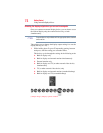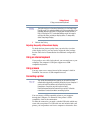
72
Getting Started
Using external display devices
Your computer will automatically detect the external display
device and activate a screen with display options. Choose the
settings you desire and click Apply. Then click OK.
Connecting to a TV using HDMI™-CEC
(Available on certain models)
HDMI™-CEC (Consumer Electronics Control) is a standard in the
CE Industry which allows devices to work together over an HDMI
cable. Toshiba computers with HDMI-CEC include a Toshiba
utility (that may need to be installed) dedicated to take advantage of
its capabilities which can allow you to:
❖ Use the TV remote control to output the computer screen onto
the TV screen.
❖ Use the TV remote control to launch, operate and close
applications on your computer.
❖ Turn on the TV when the HDMI output is selected using the
Fn+F5 key.
❖ Switch the video output (HDMI or LCD) when executing
certain desktop icons.
❖ Enable/Disable the HDMI-CEC function on the computer.
For more detailed HDMI-CEC information visit
pcsupport.toshiba.com.
Connecting the sound to a TV or stereo system
At times you may prefer to use external audio instead of the
computer’s built-in speakers. For example, when you use a TV or
other external display device you can use that device’s speakers, or
when you use the computer’s built-in display you can connect to
external speakers or a stereo sound system for higher quality sound.
You can connect the sound to external audio devices in two ways:
❖ Using the headphone jack on the side of the computer—This
lets you connect directly to headphones, powered speakers, or a
stereo system that supports input from a headphone output.
You need a cable (not included with your computer) with a 1/8"
(3.5mm) stereo plug on one end and a plug compatible with
your sound system on the other end (typically an RCA type
connector).


















